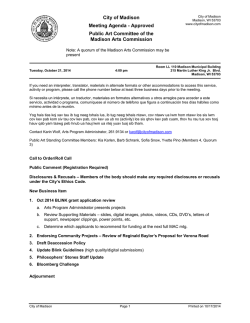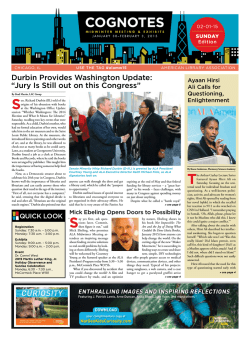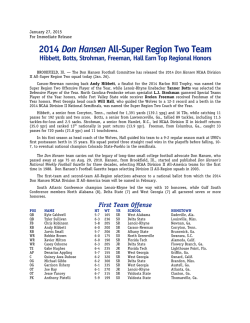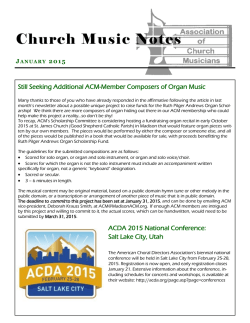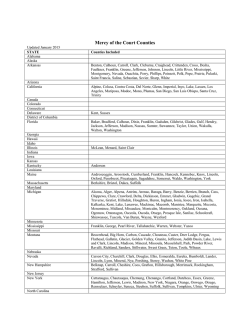
Ex parte Lisa Hanvey - Alabama Appellate Watch
REL:01/30/2015
Notice: This opinion is subject to formal revision before publication in the advance
sheets of Southern Reporter. Readers are requested to notify the Reporter of Decisions,
Alabama Appellate Courts, 300 Dexter Avenue, Montgomery, Alabama 36104-3741 ((334) 2290649), of any typographical or other errors, in order that corrections may be made before
the opinion is printed in Southern Reporter.
SUPREME COURT OF ALABAMA
OCTOBER TERM, 2014-2015
____________________
1131235
____________________
Ex parte Lisa Hanvey
PETITION FOR WRIT OF CERTIORARI
TO THE COURT OF CIVIL APPEALS
(In re: Madison Academy, Inc.
v.
Lisa Hanvey)
(Madison Circuit Court, CV-11-901578;
Court of Civil Appeals, 2120753)
BOLIN, Justice.
I.
Facts and Procedural History
1131235
On February 19, 2014, the Madison Circuit Court ("the
trial court") entered a judgment finding that Lisa Hanvey had
suffered a compensable injury caused by her exposure to
chemical fumes during the course of her employment with
Madison Academy, Inc. ("the employer").
awarded
Hanvey
The trial court
permanent-total-disability
benefits
in
accordance with the Workers' Compensation Act, § 25–5–1 et
seq., Ala. Code 1975 ("the Act").
The Court of Civil Appeals
reversed the trial court's judgment.
See Madison Academy,
Inc. v. Hanvey, [Ms. 2120753, April 4, 2014] ___ So. 3d ___
(Ala. Civ. App. 2014).
We granted Hanvey's petition for a
writ of certiorari to review whether the Court of Civil
Appeals erred in reversing the trial court's judgment awarding
Hanvey benefits for a permanent total disability under the
Act.
We reverse and remand.
II.
Standard of Review
In Ex parte Fort James Operating Co., 895 So. 2d 294, 296
(Ala. 2004), this Court stated the standard of review on a
petition for a writ of certiorari in a worker's compensation
case:
"'On certiorari review, this Court accords no
presumption of correctness to the legal conclusions
2
1131235
of the intermediate appellate court. Therefore, we
must apply de novo the standard of review that was
applicable in the Court of Civil Appeals.' Ex parte
Toyota Motor Corp., 684 So. 2d 132, 135 (Ala. 1996).
The Court of Civil Appeals, in turn, is bound by
Ala. Code 1975, § 25–5–[81](e), which provides that
legal issues are to be reviewed de novo and requires
that the judgment of the trial court be affirmed if
its factual findings are supported by substantial
evidence."
This Court has stated:
"A trial court's judgment in a worker's compensation
case based on pure findings of fact will not be
reversed if it is supported by substantial evidence.
§ 25–5–81(e)(2), Ala. Code 1975. '[The appellate
court] will not reverse the trial court's finding of
fact if that finding is supported by substantial
evidence--if that finding is supported by "evidence
of such weight and quality that fair-minded persons
in the exercise of impartial judgment can reasonably
infer the existence of the fact sought to be
proved."' Ex parte Trinity Indus., Inc., 680 So. 2d
262, 268–69 (Ala. 1996) (quoting West v. Founders
Life Assurance Co. of Florida, 547 So. 2d 870, 871
(Ala. 1989)). 'Therefore, in such a case the
appellate court must view the facts in the light
most favorable to the findings of the trial court.'
Ex parte Professional Bus. Owners Ass'n Workers'
Comp. Fund, 867 So. 2d [1099] at 1102 [(Ala. 2003)].
'Moreover, the Court of Civil Appeals observed in
Edwards v. Jesse Stutts, Inc., 655 So. 2d 1012, 1014
(Ala. Civ. App. 1995), that "the [1992 Workers'
Compensation] Act did not alter the rule that [an
appellate court] does not weigh the evidence before
the trial court."' Ex parte Phenix Rental Ctr., 873
So. 2d 226, 229 (Ala. 2003)."
Fort James Operating Co. v. Stephens, 996 So. 2d 833, 835
(Ala. 2008)
3
1131235
III.
Analysis
The trial court stated the following in its February 19,
2014, judgment:
"Lisa Hanvey was 44 years old at the time of the
trial. She has a high school education, including
attending special education classes since elementary
school. She reads on a third grade level. Her past
work history has included child care.
"The relationship of employer and employee
between Ms. Hanvey and Madison Academy existed as of
May 1, 2011, and continued at least through
September 2011. Both parties were subject to and
governed by the Workers' Compensation Act of
Alabama, as amended. Ms. Hanvey worked at Madison
Academy as a janitor from September 2006 until her
health prevented her from continuing in her job. On
June 21, 2011, the employer-supplied doctor, Dr.
Syed Hasan, took Ms. Hanvey off work, and she did
not return to work again.
"Ms. Hanvey suffers from myasthenia gravis, a
neuromuscular and autoimmune disease. The disease
impairs the normal function of the neuromuscular
junction causing muscle fatigue. It produces an
antibody which affects the function of the
acetylcholine that enables muscle contraction. The
consequence is that muscles become fatigued more
easily.
"Ms. Hanvey's primary care physician is Dr.
Cheryl Bazzle, who has treated Ms. Hanvey since
September 27, 2005. She was also treated by a number
of other doctors, including employer-provided
physicians Dr. Syed Hasan and Dr. Laurence
Carmichael.
"Following
her
last
visit
to
her
employer-provided physician, Dr. Carmichael, on July
4
1131235
26, 2011, Ms. Hanvey continued to receive necessary
medical care from her primary care physician, Dr.
Cheryl Bazzle. Neurologist Dr. Amit Arora was the
initial neurologist involved in her treatment. She
was subsequently referred to Dr. Gwendolyn Claussen
at Kirklin Clinic in Birmingham, Alabama. Dr.
Anjaneyulu Alapati took over treatment of Ms.
Hanvey's myasthenia gravis since March 29, 2012.
The medical bills for these doctors and hospital
stays, to the extent they were paid, were paid by
Ms. Hanvey's private health insurance through Blue
Cross and Blue Shield of Alabama. Ms. Hanvey went to
the emergency room at Crestwood Hospital and at
Huntsville Hospital on more than one occasion, where
she
was
hospitalized
for
treatment
of
her
symptomatic myasthenia gravis.
"Before her repeated exposure to cleaning and
stripping and refinishing chemicals in May and June
2011, and the resulting respiratory distress and
infection, her health condition had never prevented
her from working at Madison Academy for any
significant length of time; significantly, she was
able to perform her job. Even the presence of
diplopia, or double vision, which is characteristic
of myasthenia gravis and which was noted during a
routine eye exam in April 2011, did not prevent her
from performing her job despite any preexisting
conditions.
"In May and June of 2011, Ms. Hanvey was exposed
to certain chemicals at work used to clean and treat
the floors. Those chemicals are shown by their
Material Safety Data Sheets to be capable of causing
respiratory problems. For example, the urethane used
on the gym floors may cause 'nose and throat
irritation,
dizziness,
headache,
nausea
or
respiratory irritation.' The Red Tornado wax
stripper utilized by Defendant may cause harm when
breathing large amounts. The baseboard cleaner and
stripper utilized warns that it may 'aggravate
existing respiratory conditions such asthma.' Her
5
1131235
family physician. Dr. Bazzle, stated, '[W]hen she
got exposed to those floor chemicals, she did a
crash and burn, I can't breathe, show[ed] up in my
office with an 02 sat on room air of 70 percent and
had to go immediately into the ICU.' The shortness
of breath experienced by Ms. Hanvey on June 13,
2011, 'was triggered by the chemicals,' according to
Dr. Bazzle. Her doctor further adds: '... she got
exposed to chemicals, which flared up her--her
respiratory problems that she had anyway and then
triggered the immune-mediated disease that she had
going on.'
"The exposure to chemicals was more significant
in Ms. Hanvey because, according to Dr. Bazzle,
while 'any one of us could get exposed to chemicals
and develop a respiratory illness from it, ... it
would probably not cause us to have to go on a
ventilator or a BiPAP machine to maintain our oxygen
level like it did her. ... [C]learly, people who
have myasthenia are going to get sicker than other
people will when
they get respiratory infections
or--or any--anything else that goes wrong with them.
It's going to be worse.' According to Dr. Bazzle,
Ms. Hanvey's exposure to chemical fumes 'acutely
caused the decompensation of [myasthenia gravis]. It
just worsened it, aggravated it.' Dr. Bazzle, who,
in her own words, knows Ms. Hanvey better than any
other doctor and finds her to be credible, opines
that Ms. Hanvey's exposure to chemical fumes at
Madison
Academy
aggravated
the
preexisting
myasthenia gravis condition. Further, Dr. Bazzle
concludes that, 'in the absence of the exposure to
the chemical fumes at work in the May and June time
frame ... Lisa would not have suffered the
disability at the time in the manner or degree she
did.'
"During this time in June 2011, after her
exposure to the stripping chemicals at work, she
developed
what
was
diagnosed
as
respiratory
infection when exposed to the fumes, which Dr.
6
1131235
Alapati calls a trigger of myasthenia weakness. She
was referred to American Family Care by her
employer, Madison Academy, on June 21, 2011,
complaining of breathing fumes from the stripper
'Red Tornado.' Dr. Hasan recorded her symptoms as
including difficulty breathing, shortness of breath
and coughing, and he treated her with antibiotics.
In addition to prescribing Lincomycin, Levaquine,
and Ceron, Dr. Hasan injected an antibiotic and then
followed with a strong oral antibiotic for treatment
of the bronchial infection which developed from
inhalation of fumes.
"These undisputed medical records are consistent
with the testimony by the myasthenia expert, Dr.
Alapati, concerning the interplay of infection and
myasthenia weakness. Likewise, Dr. Arora stated by
letter of November 23, 2011, to Ms. Hanvey: 'We also
recommend that you stay away from a working
environment that could exacerbate your medical
condition. ... I do believe that the exposure you
have had to the chemicals more than likely caused
respiratory difficulties that led to you being
hospitalized in the intensive care unit and
ultimately led to this diagnosis. ... We would like
to avoid further episodes in the future and we have
recommended that you avoid any of these exposures in
the future as well.'
"It is Dr. Bazzle's opinion that Ms. Hanvey's
exposure to chemical fumes 'worsened' and aggravated
the myasthenia gravis. This is a worsening of the
underlying condition and not merely a recurrence of
symptoms inherent in the etiology of the preexisting
condition.
"The presence of strong chemicals at Lisa
Hanvey's
workplace
prior
to
her
respiratory
infection treated by the company doctor in June 2011
and her subsequent 'crash and burn' hospitalization
is undisputed. Ms. Hanvey's own testimony coupled
with the medical testimony consistently establishes
7
1131235
that Ms. Hanvey has suffered through the exposure to
strong chemicals that were part of her work
environment as a janitor at Madison Academy. No
evidence was presented that Ms. Hanvey was unable to
perform her work at Madison Academy prior to the
exposure.
"Through her job, Lisa Hanvey came face to face
with the two triggers of myasthenia weakness,
according to Dr. Alapati--infection and physical
activity. The respiratory infection that likely led
to her full-blown myasthenia gravis has been
previously discussed; as for the presence of the
second trigger, Ms. Hanvey performed work as a
janitor requiring very physical activity. During the
school term, Ms. Hanvey's janitorial work included
sweeping, mopping, dusting, cleaning windows,
vacuuming, with limited furniture movement. With the
end of the school term in May 2011, the physical
work increased [beginning] with the emptying of the
cafeteria for the stripping and refinishing of
floors. This was followed in like manner in the
classrooms where desks, chairs, tables, bookshelves
and filing cabinets had to be removed. Scraping the
stripper off the floors was also more physical and
unusual duties, as was scrubbing the baseboards.
Because these working conditions could trigger
future development of Ms. Hanvey's myasthenia
gravis, her physicians advised her to avoid such
physical activity. Dr. Claussen examined Ms. Hanvey
on December 1, 2011, and stated that she was unable
to work given the severity of her weakness. Dr.
Arora
completed
a
Clinical
Assessment
of
Fatigue/Weakness which characterized Ms. Hanvey's
fatigue as being present to such an extent as to be
distracting to adequate performance of daily
activities or work.
"John McKinney,
Ms. Hanvey, stating
illiterate for all
opined that, based
a vocational expert, evaluated
that she tested 'functionally
practical purposes.' McKinney
upon the assessments of the
8
1131235
various treating medical specialists, Ms. Hanvey
would be 'incapable of performing or maintaining any
and all types of substantial gainful activity in the
competitive
labor
market--even
at
the
Sedentary/Unskilled
levels
of
exertion
and
proficiency.' According to McKinney, who was the
only vocational expert to testify, Ms. Hanvey is not
a viable candidate for vocational retraining
assistance. McKinney's report is established as fact
in this matter.
"....
"The basis for compensation is the decrease in
earning capacity. Nashville Bridge Co. v. Honeycutt,
246 Ala. 319, 20 So. 2d 591 (1945). As the Court in
CVS Corp. v. Smith noted:
"'The determination of the extent of
disability is within the trial court's
discretion and cannot be disturbed on
appeal if there is evidence to support it.
Dolgencorp, Inc. v. Hudson, 924 So. 2d 727,
734 (Ala. Civ. App. 2005) (citing Golden
Poultry Co. v. Staggs, 660 So. 2d 1348,
1352 (Ala. Civ. App. 1995)). With regard to
determining
whether
an
employee
is
permanently and totally disabled, this
court has stated: "'The test for total and
permanent disability is the inability to
perform one's trade and the inability to
find gainful employment.' Fuqua v. City of
Fairhope, 628 So. 2d 758, 759 (Ala. Civ.
App. 1993). See also Liberty Trousers v.
King, 627 So. 2d 422, 424 (Ala. Civ. App.
1993). A 'permanent total disability' is
defined as including 'any physical injury
or mental impairment resulting from an
accident, which injury or impairment
permanently and totally incapacitates the
employee
from
working
at
and
being
retrained for gainful employment.' §
9
1131235
25-5-57(a)(4)d., Ala. Code 1975; Russell v.
Beech Aerospace Services, Inc., 598 So. 2d
991, 992 (Ala. Civ. App. 1992)." Alabama
Catfish, Inc. v. James, 669 So.2d 917, 918
(Ala. Civ. App. 1995). See also Boyd Bros.
Transp., Inc, v. Asmus, 540 So. 2d 757, 759
(Ala. Civ. App. 1988) (stating that §
25-5-57(a)(4)d., Ala. Code 1975, "requires
that the employee be unable to perform his
trade or unable to obtain reasonably
gainful employment").'
"CVS Corp. v. Smith, 981 So. 2d 1128, 1136 (Ala.
Civ. App. 2007). Moreover, any disability award
received by Lisa Hanvey is not subject to an
apportionment for preexisting injuries as provided
in Ala. Code [1975,] § 25-5-58[,] because Ms. Hanvey
was able to perform her duties at work prior to the
injury.
"....
"Lisa Hanvey suffered a work-related injury
through being subjected to the fumes from strong
chemicals in May and June of 2011 while at work as
a janitor at Madison Academy. She was able to
perform her job before this exposure. While she may
arguably have had a preexisting condition in the
form of myasthenia gravis, she is still entitled to
collect workers' compensation benefits because her
employment has aggravated or combined with her
myasthenia
gravis
to
produce
disability;
significantly, her doctor has concluded that 'her
disease was worsened by the exposure to chemicals.'
Because she was able to perform her duties prior to
the injury, Lisa Hanvey will receive compensation
without regard for any preexisting medical condition
or problems.
"....
10
1131235
"Moreover,
the
Court
finds
that
this
work-related exposure has rendered Ms. Hanvey unable
to return to work at her job or perform her
accustomed trade. Dr. Alapati has testified that
physical
exercises
increase
the
symptoms
of
myasthenia gravis and cause tiredness and fatigue.
Ms. Hanvey's health, coupled with her physical and
mental limitations as noted in the vocational report
and as obvious in her testimony and demeanor, will
prevent any sort of new training. Indeed, she is
excluded from the opportunity for any gainful
employment that will provide comparable compensation
and work duties, based on her own limitations,
education,
experience,
physical
and
mental
condition, and other factors noted by vocational
expert John McKinney.
"The Court finds that Ms. Hanvey suffered a
permanent injury at work, which renders her
permanently and totally disabled under the workers'
compensation laws of this state. Accordingly,
[Hanvey] is entitled to judgment in her favor for
workers' compensation benefits under the Act."
In this case, the parties do not dispute that Hanvey
suffered a compensable injury under the Act, which was caused
by her exposure to chemical fumes during the course of her
employment; instead, the dispute, as claimed by the employer,
is whether Hanvey's exposure to the chemical fumes only
temporarily aggravated her underlying myasthenia gravis.
On
appeal, the employer argued, and the majority of the Court of
Civil Appeals held, that Hanvey had proven only that her
myasthenia gravis had been temporarily aggravated by her
11
1131235
exposure to chemicals in the workplace. Specifically, the
employer contended that Hanvey experienced only a temporary
flare-up of her myasthenia gravis because, it said, the flareup was resolved with medications and Hanvey had been in
remission since Dr. Alapati began treating her.
Thus, it
says, the trial court erred in awarding Hanvey permanenttotal-disability benefits.
The issue for our review is
whether the record contains substantial evidence to support
the trial court's finding that the injury Hanvey suffered
rendered her permanently and totally disabled under the Act.
Fort James Operating, supra.
We conclude that it does.
The evidence before the trial court demonstrated that
Hanvey's exposure to the chemicals in the workplace caused a
worsening
and
substantial
acceleration
of
her
underlying
myasthenia gravis and that she was unable to return to work at
her job or to perform her accustomed trade as a janitor.
This
"worsening," according to the trial court, was a "worsening of
the underlying [myasthenia gravis] and not merely a recurrence
of symptoms inherent in the etiology of the preexisting
condition."
Prior to her exposure to the chemicals, Hanvey
had been working normally for the employer for approximately
12
1131235
five years with no disabling symptoms.
According to the
testimony, myasthenia gravis is a slow, progressive disease.
However, Dr. Bazzle testified in her deposition that, when
Hanvey was exposed to the chemicals, "she did a crash and
burn," from which "she has not risen"; that Hanvey's exposure
to
chemicals
[myasthenia
"acutely
gravis]";
caused
and
the
that,
decompensation
"in
the
absence
of
her
of
the
exposure to the chemical fumes at work ..., [Hanvey] would not
have suffered the disability at the time [and] in the manner
[or] degree she did."
Dr. Bazzle testified as follows:
"Q. ... If she's suffering from myasthenia gravis as
of May 23 of 2011, which you've indicated she was,
but it had not been diagnosed and there was no
treatment being rendered for the disease and it is
a progressive disease, it's medically possible, is
it not, that the disease could naturally progress
and worsen with time?
"....
"A. No doubt that it could progress, usually on a
slowly, you know, progressive path.
But what
happened to her was it was--might have been
continuing to progress, but when she got exposed to
those floor chemicals, she did a crash and burn, I
can't breathe, show[ed] up in my office with an 02
sat on room air of 70 percent and had to go
immediately into the ICU.
"....
13
1131235
"Q. I understand that, but my question was: Could
shortness of breath have been triggered or
aggravated by factors other than the chemicals?
"....
"A. Her underlying condition was--was certainly a
factor and yes, she's overweight and probably
deconditioned because of that and also deconditioned
because she was chronically ill from the [myasthenia
gravis] not being diagnosed.
And then she got
exposed to chemicals, which flared up her--her
respiratory problems that she had anyway and then
triggered the immune--mediated disease that she had
going on. And there you have it, this whole milieu
of–-of factors, exactly what you described, multiple
factors that--that went into a--a bad situation that
she has not risen from.
"....
"Q. ... How was the--how was [Hanvey's] exposure to
chemical fumes important in the development of
myasthenia gravis?
"....
"A. I think it--it acutely caused the decompensation
of it.
"....
"Q. Is it fair to say that in the absence of the
exposure to the chemical fumes at work in the May
and June time frame that [Hanvey] would not have
suffered the disability at the time [and] in the
manner or degree she did?
"....
"A.
Yes."
14
1131235
(Emphasis added.)
In
a
letter
dated
November
23,
2011,
Dr.
Arora
recommended that Hanvey "stay away from a working environment
that could exacerbate" her myasthenia gravis.
Dr. Arora
stated:
"I do believe that the exposure you have had to the
chemicals more than likely caused respiratory
difficulties that led to you being hospitalized in
the intensive care and ultimately led to this
diagnosis.
"We would like to avoid further episodes in the
future and we have recommended that you avoid any of
these exposures in the future as well."
Dr. Arora stated in a progress note dated January 13, 2012,
that he did not believe that Hanvey was capable of long-term
employment because of her physical condition.
Dr. Alapati testified that he last saw Hanvey on July 30,
2012, and that her myasthenia gravis had been in remission for
about six months.
Dr. Alapati testified that myasthenia
gravis could get better and worse, i.e., it could "wax and
wane."
However, he stated the following regarding Hanvey's
ability to work:
"Q. With regard to Ms. Hanvey based on your last
examination of her, do you have an opinion as to
whether or not she's able to be gainfully employed?
15
1131235
"A. Depending. If she did like work with desk work
or something like that, a lot of people go to work
in the desk work, but anything labor work, physical
activities, lifting weight, I'd advise them not to
do that because [they] can get more fatigued.
"....
"Q. And you discussed what work you would restrict
your patients to.
As I understood it, you would
tell the myasthenia gravis patients to stay away
from physical work but they could do sedentary work,
is my understanding correct?
"A.
It is, desk[work], yes.
"....
"Q. Besides physical work, have you--are you aware
of any other factors that can cause a waxing of the
symptoms or an exacerbation of the symptoms?
"A. Mainly, in my opinion, physical work and then
infections in the body are the two things that
typically trigger weakness, myasthenia weakness."
Although Hanvey's myasthenia gravis eventually went into
remission following a full-blown myasthenia gravis "crisis,"
the medical testimony presented demonstrates that any attempt
by Hanvey to engage in the type of physical labor she was able
to perform before her exposure to chemicals would cause her
myasthenia gravis to become symptomatic.
As noted by the
trial court, Hanvey's job as a janitor required very physical
work; it also required that she be exposed to chemicals.
16
1131235
Moreover, the only vocational expert to testify in this case
evaluated Hanvey and opined that she would be "incapable of
performing or maintaining any and all types of substantial
gainful activity in the competitive labor market--even at the
Sedentary/Unskilled levels of exertion and proficiency."
He
further concluded that Hanvey was not a viable candidate for
vocational-retraining assistance; hence, she is not a viable
candidate for "desk" work.
It is well settled that under the
Act a worker is permanently and totally disabled if the worker
is "incapacitate[d] ... from working at and being retrained
for gainful employment." Ala. Code 1975, § 25-5-57(a)(4)d. "A
worker is not required to be totally helpless; he simply must
be
unable
to
perform
his
trade
or
obtain
other
gainful
employment." Edmonds Indus. Coatings, Inc. v. Lolley, 893 So.
2d
1197,
1210
(Ala.
Civ.
App.
2004).
Moreover,
"[t]he
determination of the extent of disability is within the trial
court's discretion and cannot be disturbed on appeal if there
is evidence to support it."
CVS Corp. v. Smith, 981 So. 2d
1128, 1136 (Ala. Civ. App. 2007).
Based on the foregoing, we
conclude that there is substantial evidence to support the
trial court's finding that Hanvey was permanently and totally
17
1131235
disabled as a result of her exposure to chemicals in the
workplace, which resulted in a worsening and acceleration of
her underlying myasthenia gravis.
See, e.g., Edmonds Indus.
Coatings, 893 So. 2d at 1210 (holding that "substantial
evidence supports the trial court's determination that the
worker was permanently and totally disabled as a result of his
allergy to paint fumes and the resulting aggravation of his
[chronic
obstructive
pulmonary
disease],"
despite
the
employer's claim that the aggravation was only temporary). We
also quote, in pertinent part, the following well reasoned
summary written by Presiding Judge Thompson in his dissent in
this case:
"From the evidence, the trial court reasonably
could have concluded that Hanvey had [myasthenia
gravis] before the refurbishing of [the employer's]
gym and classroom floors took place, but that the
condition did not affect Hanvey's job performance.
The testimony of Dr. Arora, as well as the testimony
of Dr. Alapati, indicates that if Hanvey were to
engage in physical exertion, the [myasthenia gravis]
symptoms
would
return.
Because
Hanvey
is
functionally illiterate, she is not a candidate for
what Dr. Alapati called 'desk work.'
Therefore,
even if this court might have reached a different
conclusion from the same evidence, I believe the
record contains substantial evidence to support the
trial court's findings that Hanvey experienced 'a
worsening of the underlying condition and not merely
a recurrence of symptoms inherent in the etiology of
the preexisting condition' and that the worsening of
18
1131235
the [myasthenia gravis] resulted in Hanvey's
inability to perform her job as she had been able to
do before her exposure to the chemicals. In other
words, the record contains substantial evidence
indicating that Hanvey's exposure to the chemicals
used in the refurbishing project hastened or
accelerated the progression of her [myasthenia
gravis] symptoms to the point that she is no longer
able to perform jobs for which she is qualified,
regardless of whether the [myasthenia gravis] is in
remission.
Further, evidence indicates that
Hanvey's work-related '[myasthenia gravis] crisis'
did not create a temporary situation from which
Hanvey has recovered, or will ever recover, so as to
be able to work again.
The '[myasthenia gravis]
crisis'
Hanvey
experienced
accelerated
the
progression of the disease and left her worse off
than she was before her exposure to the chemicals.
It cut short her working life, i.e., her ability to
earn.
If not for the exposure to the chemicals,
Hanvey might have been able to continue working
normally for years to come."
Madison Academy, Inc., ___ So. 3d at ____ (Thompson, P.J.,
dissenting)(emphasis added).
On appeal, this Court must view the evidence in a light
most favorable to the trial court's findings of fact. Fort
James Operating, 996 So. 2d at 835. When substantial evidence
supports the factual finding of the trial court, an appellate
court may not reverse the trial court's judgment because there
is
also
substantial
evidence
that
supports
a
factual
conclusion contrary to the finding made by the trial court.
See Boise Cascade Corp. v. Jackson, 997 So. 2d 1042, 1047
19
1131235
(Ala. Civ. App. 2008).
Because we conclude that there was
substantial
to
determination
evidence
that
Hanvey
support
was
the
trial
permanently
and
court's
totally
disabled, we reverse the judgment of the Court of Civil
Appeals and remand the cause to that court for proceedings
consistent with this opinion.
IV. Conclusion
The judgment of the Court of Civil Appeals is reversed
and the case remanded for proceedings consistent with this
opinion.
REVERSED AND REMANDED.
Moore, C.J., and Stuart, Parker, Shaw, Main, Wise, and
Bryan, JJ., concur.
Murdock, J., dissents.
20
1131235
MURDOCK, Justice (dissenting).
In the portion of the opinion of the trial court quoted
by the main opinion of this Court, the trial court relied upon
a number of decisions holding, in reference to the potential
apportionment of compensation under §§ 25-5-57(a)(4)e. and 255-58, Ala. Code 1975, that an employee is not considered to
suffer from a preexisting condition if that condition is not
affecting the worker's job performance at the time the worker
suffers a job-related injury.
Those cases do not appear to
involve a preexisting infirmity that, though not an impediment
to job performance at the time of the new injury, would
eventually become such thereafter, even in the absence of the
new injury.
Compare Ex parte Lewis, 469 So. 2d 599, 601 (Ala.
1985) ("Since Lewis's ability to work was unaffected by the
arteriosclerosis prior to the accident, and there is no
evidence in the record to indicate that the condition would
have become symptomatic during the compensable period but for
the injury, the Court of Civil Appeals' decision affirming the
apportionment of the award for permanent disability between
the work related injury and the preexisting infirmity [was in
error]." (emphasis added)).
21
1131235
Here, Judge Moore, writing for the majority of the Court
of Civil Appeals, explains how the evidence in this case
supports the conclusion that Lisa
Hanvey recovered from the
effects of her 2011 injury and explains that it was her
underlying condition that caused her to be unable to continue
her employment at Madison Academy, Inc.
On the strength of
the factual and legal analysis of the issue of causation
offered by the opinion of the Court of Civil Appeals, I
respectfully dissent.
22
© Copyright 2026

